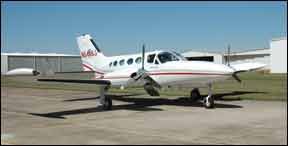Like the Lockheed Constellation, Cessna’s 421 Golden Eagle is an airplane of another age. Impossibly sleek, fast and comfortable, it’s hard to imagine such a thing ever being built at all, never mind again.
But owners rave about the 421’s exceptional combined capabilities and even though many of them could easily afford turbines or light jets, they stick with their Golden Eagles for delivering the best value for the money spent.
But that’s not to say owning a 421 is cheap. Far from it. The engines alone can amount to $50,000 or more each and with known ice, pressurization and even a lav of sorts, there’s a lot to maintain. Said one owner: “Don’t even ask what it costs to run it. That just shows you can’t afford it.”
History
The 421, which shares its basic airframe with most of the other 400-series Cessna twins, was introduced in 1968, when GA was booming along. Cessna aimed it at buyers who wanted better carrying capacity and performance than other piston twins offered, but who were put off by the high cost of turboprops.
To get the performance these buyers were looking for, Cessna decided to use Continental’s GTSIO-520 geared engines, producing a healthy 375 horsepower apiece. That’s nearly three-quarters of a horsepower per cubic inch, and the inevitable stress meant short service life. Originally, the TBO was a mere 1200 hours. Later engines sported heavier crankcases that increased TBO to a still-low 1600 hours, which is where it remains. Durability isn’t the engines’ strong point.
While most owners report that the engines will reach TBO with good care, the fact that they’re so unusual means that they’re very expensive to overhaul: an estimated $47,000 each just for the engines, plus R&R. While that’s pretty steep, it’s actually less than the overhaul cost for the 421’s two direct competitors. The Beech Duke’s engines cost $55,000 each, and the Piper P-Navajo’s engines cost $50,000 a side to overhaul.
The first 421s shared many of the features of the smaller 400s and the 300 series. The “Stabila-Tip” fuel tanks, 170-gallon fuel system, and electromechanical landing gear were all quite similar to those of the 310. The original 421 also had a short nose. Maximum gross weight was a respectable 6800 pounds. The standard fuel system gave a range of some 800 miles, while an optional 255-gallon system boosted the range to nearly 1200 miles. Owners say the higher fuel capacity is much prized and worth looking for.
The airplane was an immediate hit, with 200 sold that first year. Clearly, the Golden Eagle was something the market was looking for. As is common, refinements were immediately applied and the 1969 model was redesignated 421A. The alterations were minor: a three-inch stretch, five more gallons of fuel, and a 40-pound increase in gross weight.
In 1971 the 421B got more significant improvements. Weights (both gross and empty) increased significantly, with a maximum gross of 7450 pounds. The wingspan was increased two feet, raising the service ceiling by 5000 feet. The nose was stretched two feet to accommodate a baggage compartment capable of carrying a six-foot-long, 600-pound object, assuming the space was not taken up with extra avionics. (The compartment is about 51 inches long with the avionics bay fully occupied.) The aft cabin area could handle another 340 pounds, with a further 200 in each wing locker for a total capacity of 1340 pounds. The wing lockers serve as bays for optional fuel tanks, so they may or may not be usable for baggage.
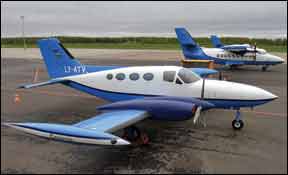
The B model gained a few extra refinements over the next four years. The pressurization system was improved, raising the pressure differential first to 4.2, then 4.4 inches. The cabin and windows were made larger and in 1975, a known-icing package was offered.
In 1976, Cessna brought out the 421C, incorporating the sweeping design changes that the company was applying to most of its twins at the time. The distinctive “Stabila-Tip” tanks (with their bladders) were gone, replaced by a simpler, bonded wet-wing fuel system. This system raised the standard fuel system capacity to 213 gallons, or 270 with all optional tanks installed.
Removing all that weight from the wing tips increased the airplane’s stability, as did an increase in the size of the fin and rudder. The end result was better handling in both normal and single-engine operations. The new wing also improved single-engine performance, with increased single-engine service ceiling and rate of climb.
The electromechanical landing gear was replaced by a hydraulic system. This featured trailing-link mains and a high-pressure nitrogen blow-down bottle for emergencies. The new system increased reliability slightly.
The maximum gross weight of the C model was 7450 pounds—the same as the B—but the standard empty weight was higher.
The C model was produced, relatively unchanged, for nine years. In 1985 it, like all the other piston Cessnas, was discontinued for lack of sales. Overall, the 421C represents about half of the production run of 1920 aircraft.
Creature Comfort
Where the 421 really shines is in its comfort, especially for passengers. While aircraft owners and pilots can debate the relative noisiness of various airplanes, the fact remains that they’re all loud: It’s just a question of how loud. The 421’s cabin is among the quietest in the business, thanks mostly to its geared engines that produce plenty of power at low prop speeds.
The pressurization system delivers shirt-sleeve comfort at altitude, providing sea-level pressure up to 10,000 feet and maintaining at 10,000-foot cabin altitude at true altitudes of more than 26,000 feet.
The cabin is also quite wide at 55 inches and has sufficient room for such amenities as a galley and toilet. “It is because of these capabilities that I sold my very early position on the Eclipse when I finally saw the mock-up plane at Oshkosh. That nice little jet would have brought me to the destination a half hour earlier, but I would have been forced to leave most of my stuff behind,” one 421 owner wrote us.
The 421’s ample baggage compartments also contribute to usable cabin space. For most flights, it’s not necessary to carry anything in the cabin. As is common in many cabin-class twins, the door is blocked by the left-rear seat. To get in or out, you have to move that seat all the way forward. This can complicate emergency egress and make for some musical chairs during loading.
Up front, the cockpit is generally we’ll laid-out, with good seats offering plenty of adjustability. The view outside is hindered a bit by the thick window pillars. On ice-equipped 421s, the entire windshield is heated, eliminating the flat hot plate common on many twins.
The panel shows good design for the most part, with the engine gauges right up top and near the pilot’s line-of-sight, where they ought to be. On the 421C, the fuel gauge is way over on the right (out of sight, out of mind), but is a capacitance type calibrated in pounds, which is more accurate than float gauges. Many owners have added modern glass and totalizers to render the mechanical gauges superfluous.
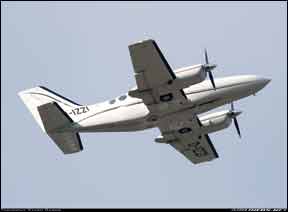
Handling
Owners report that the 421 has no real vices, and makes for a good, stable instrument platform. If it comes down to a choice between models, however, we recommend the C version. Eliminating the tip tanks, increasing the wing span and enlarging the fin and rudder made for somewhat improved handling, particularly in roll and during single-engine operations. The changes also improved stability in turbulence.
Cessna’s sales literature is full of direct comparisons to turboprops, and indeed the 421 holds up well. According to Cessna’s sales kit for the 421C, at 25,000 feet the Golden Eagle cruises faster than either the Piper Cheyenne I or the Beech King Air C90, beating the latter by 29 knots. All-engine rate of climb is almost 200 FPM better than the Cheyenne and within 15 FPM of the King Air. Service ceiling is much higher with both engines running and quite close with only one prop turning. Single-engine rate of climb is not as good—no surprise there—but it’s still within striking distance, about 200 FPM less than the King Air.
On paper, the 421 is quite fast. In the real world, though, cruise speeds are a bit less. Pilots report flight planning for anywhere from 195 to 215 KTAS at about 20,000 feet. Fuel burn is 50 gallons for the first hour, 40 thereafter. On shorter hops, however, it doesn’t pay to climb that high. Trips of 300 miles or less are normally flown at lower altitudes and speeds.
Like most aircraft, the 421 is not able to fill all the seats, baggage compartments and fuel tanks at the same time. It will, however, carry four or five adults, their bags and full or near-full fuel. Owners are unanimous in their praise of the airplane’s real-world usefulness in load carrying.
“Sometimes we look like the Beverly Hillbillies when we unload the plane and tie a bunch of strollers and bikes onto the roof of the car,” said owner John Keagy.
Systems
Systems-wise, the 421 is quite complex, with both good and bad points. The fuel system is a case in point. The 421C has a simpler system than earlier 421s, which generally simplifies management. It’s far less complicated than, say, a 310. But the wing locker tanks, which have no gauges (just “empty” lights), are used by transferring fuel to the mains via an electric pump. If there isn’t room, the fuel goes overboard. Also, the pump is fuel-lubricated and will burn out if left to run too long after the locker tanks are dry.
Good points include the availability of fire detection and extinguishing systems for the engine nacelles in later models, a good annunciator panel and an available angle-of-attack indicator.
Engines
Cessna chose the geared Continentals for their combination of high power and low prop speeds, which allowed the 421 to deliver good performance without punishing noise levels. But, the geared engines proved to be more delicate than their direct-drive siblings, developing a reputation for cracking cases.
The owners who responded to our survey all noted that they will go to TBO if treated well. That TBO was, in the early models, a dismally short 1200 hours. Later engines had beefed-up cases that raised the mark to 1600, typical for engines of this size, but this did not eliminate the case-cracking problem entirely.
Temperature and throttle abuse are pure poison: those GTSIO-520 engines need to be carefully managed. Overboosting on takeoff is one of the big reasons behind the GTSIO’s case-cracking reputation. The throttles must be handled slowly and carefully, with the pilot constantly checking manifold pressure during the ground roll, watching for upward deviations.
In flight, engine temperatures demand attention. Cylinder head temperatures that go too high or too low lead to cylinder problems. Letting down calls for precise planning to prevent shock cooling. Steady climbs demand equally good management.
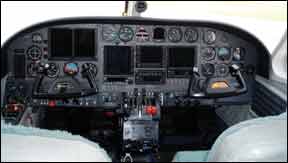
One charter operator who wrote in had a different engine complaint, one aimed at Continental for taking a very long time (several months) to deliver factory remanufactured engines.
Of course, the 421 also shares the exhaust system design with other turbocharged Cessna twins, and this system was implicated in a string of accidents during the late 1990s which resulted in 29 deaths. The difficulty with the system stems from the location of the turbocharger, which is mounted to the airframe rather than the engine. This requires a flexible exhaust system to allow for differential movement of the engine and turbo. Cessna achieved this flexibility through a combination of ball and slip joints. This system can develop cracks, which allow hot exhaust gases to escape.
The hot exhaust then hits the aluminum box-beam keels that serve as engine mounts. These burn through, serving as a conduit to allow the gases to strike and burn through the firewall to the unprotected fuel crossfeed lines beyond. These lines have no shutoff valves.
In some cases, the exhaust weakens the wing spar, which then fails. In others, the loss of the fuel lines results in dual engine failure due to fuel starvation.
The fact that the exhaust is a weak link is nothing new. A 1975 AD requires visual inspections every 50 hours, but the plumbing is so convoluted and tightly packed that this is difficult to do.
The string of accidents prompted the Cessna Pilot’s Association to call for immediate, thorough visual inspections of the exhaust system, including removal of top and bottom cowls, induction air filter canisters, head shield and anything else that might block an inspection. The Association also called for a complete pressure check of the system. The CPA and AOPA also called on the FAA to issue an emergency AD, though none appeared.
One of the latest ADs is in fact on the exhaust system. AD 2000-01-16 requires inspection and replacement of exhaust system components, but it’s not 421 specific. The 300 series is also covered. This AD supersedes 75-23-8. Other ADs of note include 95-9-13, replacement of non-compliant fuel inlet valves; 92-16-8, modification of commuter seats and tracks; 91-25-8, repetitive inspection of the wing front spar upper caps; and 90-2-13, inspection/replacement of the main landing gear inner barrel bearings.
Mods, Groups
The same mods available for other 400-series Cessnas can also be had for the 421. Notable ones include engine upgrades and winglets from RAM, vortex generators from Micro Aerodynamics, Robertson and V/G Systems, STOL kits from Sierra Industries, speed brakes/spoilers from Precise Flight and Spoilers, Inc., and intercoolers from American Aviation.
A club that covers the 421, in addition to all other twin Cessnas, is The Twin Cessna Flyer. It was originally started by Larry A. Ball but is now run by Bob Thomason, who also edits the association’s must-have magazine, The Twin Cessna flyer. Contact at www.twincessna.org.
Also worth joining is the Cessna Pilot’s Association (www.cessna.org, 805-934-0493).
Owner Comments
I am the second owner of a 1982 Cessna 412. Its first owner, like myself, used it as his personal airplane and it was never flown for hire. Since a lot of my flying has been between the Midwest and the Rocky Mountains, I found the 414 I owned definitely underpowered, especially in the summer. The first 421 solved that problem.
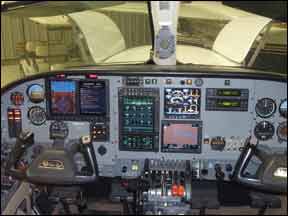
The 1980 model introduced a trailing link gear and, in 1982, improvements were introduced to the engines with heavier cases and a seventh nozzle. Differences between the Cessna 421 models are striking. I think that for speed, range, level of pressurization, de-icing capabilities, and loading capabilities combined, no airplane can rival the 421, unless you step up to a whole different class of aircraft.
I generally fly in the low 20s and get 230 knots true airspeed at 65 per cent power, gulping about 38 GPH. You can fill all tanks, including the auxiliary tanks, for a total of 260 gallons, and be left with an astounding payload of more than 950 pounds.
One can fly nonstop from Chicago to Denver with IFR reserves, even a with headwind.
It is because of these capabilities that I sold my very early position on the Eclipse when I finally saw the mock-up plane at Oshkosh. That nice little jet would have brought me to the destination a half hour earlier, but I would have been forced to leave most of my stuff behind.
The 421 is a very stable airplane and surprisingly forgiving. Approaches are very relaxing since once you have set up the numbers, the airplane essentially flies itself down to the runway with very little input. But you want to fly this airplane by the numbers, like most complex airplanes.
I rarely need any work done in between annuals and the typical annual costs between $7000 and $10,000, not a tremendous amount for an airplane of this size and complexity.
There are several modifications available to make it even better. For example, vortex generators bring the stall speed down to 70.5 knots and increase the gross weight by 129 pounds to 7629 pounds. Speed brakes will allow you to stay high much longer to avoid turbulence closer to the ground, so common in the west. You can come down at 1500 feet per minute with very little change in power. The engines love that. The panel is enormous and you can put all the toys you like in there. I just finished the installation of the new Garmin GTN 750/650 boxes, both linked to an EX500 and a Sandel 3500.
Finally, something needs to be said about the myth of the “troubled geared engines” that people, mostly without experience in these airplanes, like to talk about. It is true that these engines need to be treated properly, especially if you are the one who will pay for their maintenance. Throttles need to be moved in a slow, deliberate manner, and, especially, descents have to be made with slow, progressive decrease in power. Treated well, these engines will make it to TBO.
Pound per pound, the Cessna 421, especially the few airplanes produced from 1982, has to be one of the best airplanes ever engineered.
Mauro C. Dal Canto
Chicago, Illinois
In September 2004, after a long search, a 1981 421C with 262 gallons and no damage history came on the market through Blackhawk. Blackhawk had taken the 421 in trade from a buyer who purchased a Conquest I with Blackhawk’s upgraded engines.
Within two weeks of Blackhawk putting the plane on the market, we had agreed upon a price. After negotiating a number of pre-buy squawks, Blackhawk agreed to my number and I wired funds to escrow.
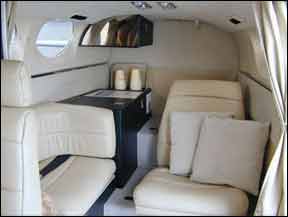
The first few months of ownership were largely consumed with maintenance on the Cessna 800B autopilot and its associated gyros and altimeter, tweaking engine fuel flows, installing GAMIjectors and battling the heater. Thereafter, I had almost no maintenance to the autopilot itself, but was spending about $3000 per year on the associated gyros, altimeter, and altitude selector. One of the hard lessons I learned early on is to never exchange these 4-inch gyros or the delicate altimeter; always get your own stuff repaired.
My first annual inspection was about $40,000—even after the $50,000 in post-purchase work—mostly due to my desire to comply with as many Service Bulletins as possible, as we’ll as other improvements and inspections that I wanted. My second annual was under $30,000, my third and fourth about $12,000. And, of course, there was no shortage of expenses between annuals. In the last five years, maintenance has averaged about $27,000 per year with an average flight time of 110 hours per year.
My GTSIO-520-N maintenance experience has been phenomenal. My initially mid-time engines are now at TBO without my having had to remove a single cylinder. The engines are delightfully smooth and run we’ll as long as the mags, harnesses, plugs, baffles and fuel flows are kept in shape.
As for flying, 421s are incredibly comfortable and quiet, with low prop RPM. They’re roomy, pressurized, air conditioned, toilet equipped and usually heated when need be. Before our kids arrived, my wife and I could load up with bags and 262 gallons useable and travel 1000-plus miles as long as headwinds were less than 20 knots.
My current useful load is 2190 pounds. However, I use about 100 of those pounds with my normal assortment of stuff: lifevests, headsets, water, oil, tools and spare parts.
I usually stay at FL190 or below with the kids, which yields a cabin altitude of about 7000 feet. And I can keep the cabin rate change to 300 feet/minute or less. The cabin is big enough that the kids can wander around in cruise and the toilet gets frequent use on family trips.
I would preach the importance of annual sim training, but the insurance companies seem to have a strong mandate covering that. I was very pleased with my years at Flight Safety International and thoroughly displeased by one experience at a discount recurrent sim training center.
My double overhaul is coming up in January. By the time I add in install expenses and various accessories, I expect to easily hit $160,000, so that’s 1600 hours x $100/hour just for the engines.
Despite the high cost of owning and operating a 421, my research indicates that it is not possible to upgrade from a 421 to something more capable without being subject to a large increase in marginal cost. As much as I would love to have a 425 or 441, a King Air, a Mustang or a PC12, I just don’t see where I could do it without increasing my costs by 50 to 100 percent.
Daniel R. Herr
Via e-mail
Our company operates a 421 in Ontario, Canada, the aircraft is used primarily for business and charity flying. In the five years we have operated the aircraft, it has become an integral part of the business. For the average leg length we fly, it is the ideal aircraft with enough payload and known icing capability to make it a reliable, safe operation.
We have considered replacing the aircraft with a turbine, but given our present route structure, the numbers are on the side of the 421. We are fortunate in having an excellent AMO looking after our maintenance, Griffin Technical Services, located in Lachute, Quebec.
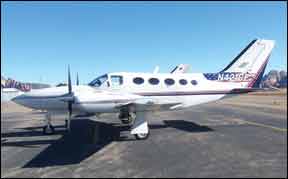
We do not fly the aircraft single-pilot IFR. In fact, I use the other seat as a training tool to give deserving young pilots real-world, multi-engine IFR experience. All in all, the 421 fills a niche not covered by any other aircraft.
Larry Loretto
Via e-mail
I’m an owner/pilot of a 1980 421C. I’ve had 100% dispatch reliability in 550 hours of use over the last six years. The biggest maintenance delay that we’ve had was only a few hours and then we were on our way. Of course, my beauty gets great maintenance from Turbine Air in Hayward, California, a shop that specializes in Cessna twins.
Both the cockpit and passenger seating are super spacious. Getting into and out of the pilot and copilot seats is far easier than other piston aircraft and VLJs. My wife often looks quite comfortable in the back, sleeping in seats that recline like business class. We have plenty of room for our large dog to stretch out on the floor and once we even brought a dresser along.
We routinely find that we can fit more into our airplane even when the seats aren’t full than we can fit into our Suburban. Sometimes we look like the Beverly Hillbillies when we unload the plane and tie a bunch of strollers and bikes onto the roof of the car.
The pressurization system works great. I’d struggle to go back to travelling with young kids and a dog without pressurization. We travel at 25,000 feet with no problem and I often do fly over moisture even though the plane is known-ice certified. I love the heated glass windshield and I’m thankful I don’t have to stare through a hot plate.
If you want a comfortable, pressurized, known-ice-certified family airplane, then the 421 is the optimal choice. A Conquest would be safer and faster, but since it features the same cabin, I’m not sure that my wife would know the difference, which means it probably isn’t worth the huge extra cost.
John Keagy
Via e-mail
We have owned our 1982 Cessna 421C Golden Eagle for six years. Awesome tends to be an over-used word but in this case, most fitting. Our business requires an (almost) all-weather airplane for Western flying. Our typical flight is 1.5 to 2 hours with the occasional 4- to 4.5-hour haul. There isn’t much to not like about the 421C. Trailing link gear makes me look good on virtually every landing. We have the option of up to 272 usable gallons of fuel for the long trips. Standard fuel in the wing main tanks is 206 gallons, which is more than adequate for most of our round trips.
We typically cruise in the mid-teens at 1700 RPM, 30 inches of MAP, 200 to 210 knots true on 38 to 39 GPH. Rate of climb at 130 knots indicated and normal weights is usually around 800 FPM. Useful load is almost 2200 pounds. Typical load (fuel and folks) for us is about 1700 pounds.
We only go up into the 20s for weather or good eastbound winds, but even then, seldom much higher than FL 230. Fill up all of the tanks, throttle back to about 185 knots and my passenger and I can make it from Concord, California, to Dallas Love non-stop, plus reserves. Alternatively, put in enough fuel for a trip to Van Nuys and put in six adults and a few bags with weight to spare.
The 421 is the most comfortable piston airplane I have flown in and more comfortable than some turboprops and older jets. The comfort is derived from a solid airframe that handles turbulence quite we’ll and the ability to turn the props at such a low speed.
Cautions: We were concerned about the negative press on the geared engines but have found that if they are flown gently (no ham-fisted power changes and keep MAP up on descents and final approach; speed brakes help with that) and consistently, they present no particular problem. Having owned lots of Continental engines, we are used to eternally chasing small oil leaks. Like any airplane, it pays to have maintenance done by someone familiar with the airplane. We have been happy with Pacific Aircraft Service in Modesto. We put GAMIjectors on the engines a couple of years ago, ran all of the tests and replaced some of the injectors for better balance. I don’t think they helped much on smoothness and the engines still are too rough for me operating lean of peak. One thing we learned is that if the airplane sits for an extended period—months—the oil pumps may need to be primed. That happened to both of our engines when we went to pick up the finished plane after the paint and upholstery. No oil pressure on start up gets your attention.
David P. Herrmann
Danville, California

